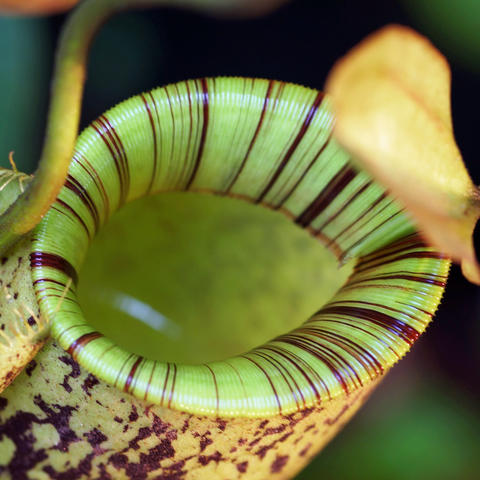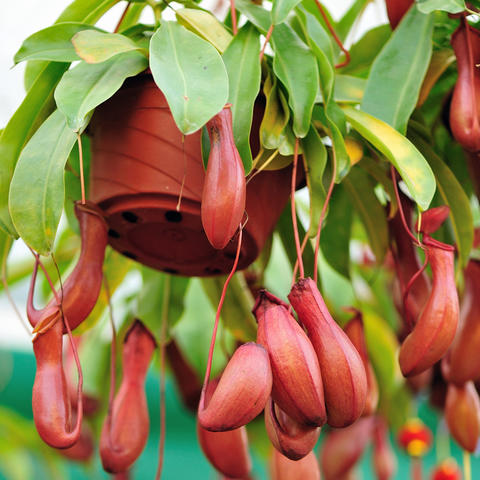Tropical Pitcher Plant
Tropical pitcher plants are challenging roommates, but perfect for fans of plants that are a little bit different. Here are our care tips for the unusual carnivorous plant.
Factsheet
- Growth characteristics
-
- bizarre
- overhanging
- loosely
- Tendrils
- Flower color
-
- yellow
- brown
- Flowering time (month)
-
- March to September
- Flower shape
-
- panicles
- Cluster
- Flower characteristics
-
- non-pleasant odor
- dioecious
- Leaf color
-
- green
- yellow
- red
- multicolored
- page format
-
- oblong
- Sheet properties
-
- evergreen
- Fruit shape
-
- Capsule
- Light
-
- sunny
- Soil type
-
- stony to sandy
- Soil Moisture
-
- moderately humid
- ph value
-
- weakly acidic
- Lime compatibility
-
- sensitive to lime
- Decorative or utility value
-
- Leaf ornaments
- Use
-
- Interior greening
- Planters
- Warm House
- Garden style
-
- Pot garden
Tropical pitcher plants (Nepenthes) are the only genus in the family Nepenthaceae. And they also occupy a special place among carnivorous plants (carnivores): They are the largest of all carnivorous plants. Most of the approximately 92 currently known species are micro-endemic species, in other words, they are only found in very limited mountain areas. Many of them are unfortunately already extinct. In their natural tropical habitats, pitcher plants grow at altitudes as high as 11,500 feet. The extreme temperatures that they are exposed to there should be taken into account when cultivating the exotic plants in greenhouses or terrariums, which is where most of them need to be kept in this country.
With tropical pitcher plants, a distinction is made between lowland species, which require a constant year-round temperature between 77 and 95 degrees Fahrenheit, and highland species, which are accustomed to a hot 86 degrees Fahrenheit during the day, but need a much cooler nighttime temperature of around 59 degrees Fahrenheit to thrive. Retailers in this country therefore mainly offer Nepenthes hybrids (there are now more than 200 different types, and rising), which are easier to care for and more robust than the wild forms. They are the result of crosses between central highland species like Nepenthes ventricosa, Nepenthes veitchii or Nepenthes fusca, and their cultivars.
Pitcher plants were very popular with the aristocracy and wealthy upper classes as early as the end of the 19th century. Today, hybrids that are kept as houseplants are still very challenging to care for, but their spectacular and extravagant appearance makes it well worthwhile. A few even thrive with normal indoor cultivation.
The tropical pitcher plant is a carnivorous plant which, unlike the well-known Venus flytrap (Dionaea muscipula), does not actively catch its prey, but sets up passive traps in the form of pitchers. The pitchers from which the pitcher plant takes its name have a capacity of a good two liters. The digestive fluid inside is very acidic (it has a pH of three) and contains numerous enzymes which can completely decompose some prey within just two days. The pitchers slowly die off after around three months. Secretions of nectar around the mouth of the pitcher help to attract prey and the ridges of the outer rim guide insects inside. Once they have fallen in, insects have no chance of climbing back up the smooth walls. The lid of the pitcher cannot move, it only serves to protect the tropical pitcher plant against rain, preventing prey from being washed out of the trap or the fluid inside from being diluted too much. The stem of the pitcher allows the plants to firmly anchor themselves to trees. In its natural habitat, the vine-like stem can grow to lengths of over 30 feet. As houseplants, tropical pitcher plants do not generally form shoots longer than ten feet.
Its appearance varies widely, both in terms of color and also shape. The reason for this is the immense adaptability of the tropical pitcher plant, allowing it to catch both crawling and flying insects. A distinction is therefore roughly made between pitcher plants with lower pitchers (usually round) and upper pitchers, which are generally cylindrical or tubular in shape. As appearance varies greatly from plant to plant, but also depending on age, clear identification of species is very difficult, even for experts.
Each tropical pitcher plants consists of three different leaf forms. At first glance, the “normal” long, green, partly reddish colored, and slightly fleshy leaves develop from a more or less pronounced basal rosette. The vine-like long shoots or tendrils, which grow upwards and can reach considerable lengths, are actually leaves. The pitchers are also leaves, namely a modified leaf lamina. They sit at the end of the long stems. The color palette of the pitchers ranges from green and yellow to red. Some species also have multicolored or speckled pitchers.

As houseplants, tropical pitcher plants rarely flower, but when they do, flowers appear between March and September. They sit on 20 to 40 inch long stems. Male flowers give off an unpleasant odor that smells like excrement and in nature attracts insects.
The female flowers produce seeds, provided they have been fertilized.
The more robust Nepenthes hybrids also ask a lot of their owners. They need high humidity, 60 per cent or more depending on the species, year-round temperatures between 68 and 86 degrees Fahrenheit (without large fluctuations), and a very sunny spot in the house. Otherwise, tropical pitcher plants will not form any pitchers. It’s not possible to provide the exotic carnivores with these conditions in a normal living room, so most pitcher plants can only be kept in a greenhouse or terrarium. The same applies to most new hybrids, which are often advertised as houseplants in stores, however experience has shown that they fare better in a terrarium.
As a carnivore, the tropical pitcher plant also requires a special substrate, which is tailored to the needs of the carnivorous plants. You can find this in specialist stores. To aerate it a little more, we recommend mixing expanded clay, coconut fibers, or perlite into the substrate.
Tropical plants, such as pitcher plants, also need plenty of water when grown indoors. They should only be watered using softened water or rainwater, and this should be given to the plants via the saucer rather than the substrate. Avoid waterlogging, but keep the substrate constantly moist. If you water it too little and the pitchers start to wilt, make sure to quickly increase watering. Spraying the plant regularly can make up for a humidity that is too low.

Important: Pitcher plants should not be fertilized! They get all the essential nutrients from their leaves, the substrate, and the prey that fall into their traps.
Tropical pitcher plants should be repotted when their pot has become too small for them, but only in summer during their growth phase. This is when the plants are at their strongest and better able to cope with the process. Choose a pot which is a few sizes bigger, as the plant should be repotted with its old substrate. This should not be shaken off the roots.
The tropical pitcher plant does not need pruning in the traditional sense of the word. However, you should hard prune the plant once if it does not form pitchers. Move it to a more suitable location and in most cases, you will see that the plant produces fresh new shoots and pitchers.
Nepenthes x ventrata (Alata x ventricosa) is one of the newer tropical pitcher plant hybrids, and is particularly well-suited to those who are new to carnivorous plants. The plant can cope with an astonishingly low humidity and can even be grown indoors in a hanging basket. However, the plant will do even better in a terrarium or a temperate greenhouse. Nepenthes hybrids with a more compact growth habit are of course well-suited to terrariums. Cultivars that have been created from crosses with Nepenthes gracilis, Nepenthes singalana, and Nepenthes tobaica have proven their worth. The varieties ‘Bloody Mary’ (bright red pitchers), ‘Hookeriana’ (green-yellow, bulbous pitchers with red speckles), and ‘Louisa’ (forms hairy pitchers) are challenging, yet extremely eye-catching.

Note: Most of the tropical pitcher plants sold online and in specialist stores do not have digestive fluids in the pitchers. Therefore, as soon as possible after taking the plant home, you should fill the pitchers about one third full with rainwater or softened water.
The tropical pitcher plant is diecious, meaning that there are both male and female plants. Since, in contrast to their natural habitat, tropical pitcher plants grown indoors rarely flower at the same time (or are only kept in groups), it is very rare that they produce seeds. Tropical pitcher plants can, however, be propagated from cuttings.
Tropical pitcher plants are inherently very resilient to plant diseases and pests. Problems of this kind are almost unheard of. On the other hand, care mistakes can quickly lead to the demise of these demanding plants. Although they love the sun, tropical pitcher plants are prone to sunburn - especially after winter. Root rot caused by waterlogging can quickly become fatal for tropical pitcher plants.

